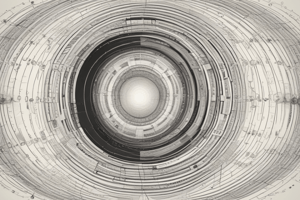Podcast
Questions and Answers
What do stage directions in a dramatic script primarily convey?
What do stage directions in a dramatic script primarily convey?
- Information to the actors, designers, and directors (correct)
- Descriptions of the characters' backgrounds
- Details about the characters' emotions
- Dialogue spoken by the actors
How do playwrights use stage directions in a dramatic script?
How do playwrights use stage directions in a dramatic script?
- To communicate important information and details about the play (correct)
- To insert additional lines for the actors
- To provide detailed descriptions of the characters' appearance
- To describe the historical context of the play
Which of the following is a common characteristic of stage directions in a drama?
Which of the following is a common characteristic of stage directions in a drama?
- They focus primarily on the historical context of the scene.
- They describe where and when the scene is set. (correct)
- They contain the characters' spoken lines.
- They are always directly presented to the audience.
What is the purpose of using ellipses (...) in a playwright's text?
What is the purpose of using ellipses (...) in a playwright's text?
In stage directions, what does the use of a dash (-) typically indicate?
In stage directions, what does the use of a dash (-) typically indicate?
What is the primary function of parenthetical stage directions in a playwright's text?
What is the primary function of parenthetical stage directions in a playwright's text?
What do the stage directions in 'A Raisin in the Sun' reveal about the interior setting?
What do the stage directions in 'A Raisin in the Sun' reveal about the interior setting?
In the context of stage directions, which of the following best describes 'upstage left'?
In the context of stage directions, which of the following best describes 'upstage left'?
How do playwrights use parenthetical stage directions in plays like 'A Raisin in the Sun'?
How do playwrights use parenthetical stage directions in plays like 'A Raisin in the Sun'?
How are contextual stage directions typically aligned on a page?
How are contextual stage directions typically aligned on a page?
In writing dialogue, what do parenthetical stage directions help guide?
In writing dialogue, what do parenthetical stage directions help guide?
Where are parenthetical stage directions typically placed?
Where are parenthetical stage directions typically placed?
How are parenthetical stage directions usually formatted?
How are parenthetical stage directions usually formatted?
What does the dash in a parenthetical stage direction indicate?
What does the dash in a parenthetical stage direction indicate?
How are parenthetical stage directions different from contextual stage directions?
How are parenthetical stage directions different from contextual stage directions?
Flashcards are hidden until you start studying
Study Notes
Understanding Stage Directions
- Stage directions primarily convey the actions, movements, and settings of characters in a dramatic script.
Purpose of Stage Directions
- Playwrights use stage directions to guide actors, directors, and designers in interpreting the script and creating the performance.
- A common characteristic of stage directions is that they are often written in the present tense.
Formatting and Punctuation
- Ellipses (...) in a playwright's text indicate a pause or trailing off in speech.
- A dash (-) in stage directions typically indicates a break or interruption in action.
- Parenthetical stage directions are used to provide additional context or clarify the action, and are usually placed in parentheses.
Placement and Alignment
- Parenthetical stage directions are typically placed near the relevant dialogue and aligned with the character's name.
- Contextual stage directions, which describe the setting and overall action, are usually centered on the page.
Guiding Dialogue
- Parenthetical stage directions help guide actors in their delivery of dialogue, indicating tone, emotion, and physical action.
- They are usually formatted in lowercase and placed in parentheses.
Key Differences
- Parenthetical stage directions differ from contextual stage directions in that they provide specific guidance for actors, whereas contextual directions describe the overall setting and action.
Studying That Suits You
Use AI to generate personalized quizzes and flashcards to suit your learning preferences.




